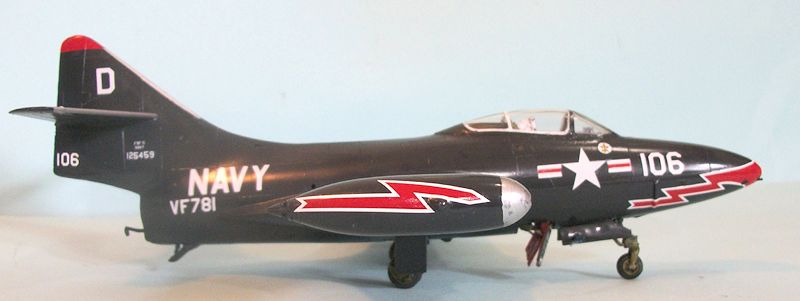
Monogram 1/48 F9F-5 Panther
| KIT #: | 5456 |
| PRICE: | OOP but not impossible to find |
| DECALS: | One option |
| REVIEWER: | Tom Cleaver |
| NOTES: | Eagle Strike 48114 “F9F Panther” decals |

| HISTORY |
By rights,
Grumman F9F-5 Panther BuNo 125459 should be the most famous Panther of all, and
her pilot, Lieutenant Royce Williams, the most famous Panther pilot of all.
However, immediately after the event for which this
acclaim should have been awarded, Cold War politics closed in on one of the few
events where the major adversaries - armed forces of the United States and the
USSR - engaged in direct combat; the events of November 18, 1952 were a
closely-guarded Navy secret until details were released by the Russian
government in the 1990s.
It is well known
that the Grumman F9F Panther, the Navy’s first line fleet fighter of the Korean
era, was a first generation jet fighter outperformed by the Soviet’s second
generation fighter, the MiG-15.
Indeed, on the two occasions where Panthers had tangled
with Migs in November of 1950 and 1951, only superior pilot skill had brought
the Navy fighter out on top.
Such facts make the achievement of Lieutenant Williams a
year later even more extraordinary.
After two years
of flying interdiction strikes in central North Korea against the communist
supply lines, Task Force 77 had finally been given orders to make a direct
strike against the hub of the Chinese
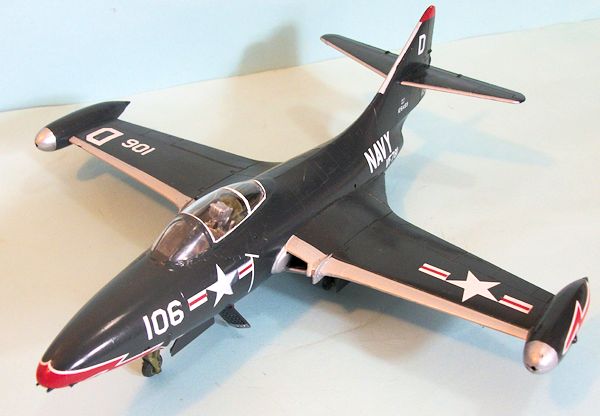 Communist
supply line.
Four carriers would strike the North Korean port city of Hoeryang,
at the mouth of the Yalu River on the east coast of the Korean peninsula, five
miles across the water from Vladivostok, the main Soviet base on the Pacific and
directly across the river from Manchuria.
Because of the international sensitivity, the strikes
could only be made in one direction from the southeast, with exit from the
target to the southwest.
November 18 was the dead of winter, with a cloud ceiling
of 500 feet over the Sea of Japan in driving snow flurries from a Siberian
blizzard.
Nevertheless, the morning strikes were flown, and preparations
were being made for a second when the fleet’s air defense radars picked up
incoming bogies from the direction of Vladivostok.
Communist
supply line.
Four carriers would strike the North Korean port city of Hoeryang,
at the mouth of the Yalu River on the east coast of the Korean peninsula, five
miles across the water from Vladivostok, the main Soviet base on the Pacific and
directly across the river from Manchuria.
Because of the international sensitivity, the strikes
could only be made in one direction from the southeast, with exit from the
target to the southwest.
November 18 was the dead of winter, with a cloud ceiling
of 500 feet over the Sea of Japan in driving snow flurries from a Siberian
blizzard.
Nevertheless, the morning strikes were flown, and preparations
were being made for a second when the fleet’s air defense radars picked up
incoming bogies from the direction of Vladivostok.
Aboard USS
Oriskany (CV-34)four F9F-5 Panthers of
VF-781 were moved to the launch position to reinforce the standing CAP in the
face of the incoming threat.
Normally, a fighter division is composed of pilots who
have flown with each other and know each other’s abilities.
In this case, the four pilots assigned had never flown
with each other and were chosen due to the fact that they had not had much
opportunity for operational flying since VF-781 and its air group had begun
their second Korean tour of duty on November 5.
The division leader was Division leader Lieutenant
Claire Elwood, with wingman Lt.(j.g.) John Middleton, with Lieutenant Royce
Williams as element lead with wingman Lt.(j.g.) David Rowlands.
Williams had
joined VF-781 the previous summer.
A graduate of the Navy’s V-5 program who had won his
Wings of Gold just too late for participation in World War II, Williams had
remained in the post-war Navy.
In 1948, he had been sent to the University of Minnesota
to obtain a Bachelor’s degree.
While there, he had become friends with Lieutenant
Commander Stan Holme, at the time the executive officer of the Naval training
detachment at UM.
Upon graduating in June 1950, Williams had expected to
return to the fleet with the outbreak of war on June 25, but instead he was sent
to two years of post-graduate study at the Armed Forces Post Graduate School in
Monterey, graduating in June 1952.
Assigned to a Corsair squadron at NAS Alamitos in
southern California, Williams spotted the brand-new F9F-5 Panthers of VF-781,
and quickly discovered that the squadron CO was Stan Holme.
A quick transfer had been authorized and Williams was in
the squadron when it became the first to take the new improved Panther into
combat that fall.
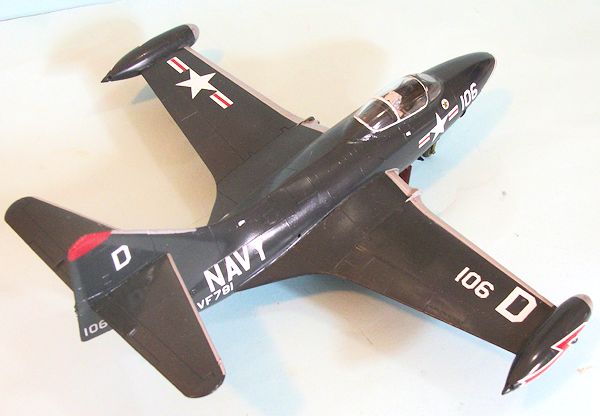 The four Panthers were immediately on instruments as they launched into the
storm and were soon swallowed in the blinding snow flurries within the clouds,
their noses high, climbing under full power at 5,000 feet per minute.
CIC informed them the bogies were 85 miles inbound at
50,000 feet.
At 12,000 feet, they broke out of the storm clouds into clear
skies, and continued climbing.
At 24,000 feet they spotted seven contrails high above,
with silver arrows at their head.
Williams, one of the best shots in the Navy, quickly
cleared his four 20mm cannons with a burst of fire. “I flipped on my gunsight
and fired a burst to test my guns.
At that moment, Lieutenant Elwood, the Flight Leader,
reported his fuel pump warning light had come on.
The CIC directed him to report overhead the Oriskany.
He passed the lead to me and turned back to the task
force with his wingman flying as his safety escort.”
The odds went from four against seven to two against
seven as the MiGs continued inbound and the two Panthers continued climbing.
The four Panthers were immediately on instruments as they launched into the
storm and were soon swallowed in the blinding snow flurries within the clouds,
their noses high, climbing under full power at 5,000 feet per minute.
CIC informed them the bogies were 85 miles inbound at
50,000 feet.
At 12,000 feet, they broke out of the storm clouds into clear
skies, and continued climbing.
At 24,000 feet they spotted seven contrails high above,
with silver arrows at their head.
Williams, one of the best shots in the Navy, quickly
cleared his four 20mm cannons with a burst of fire. “I flipped on my gunsight
and fired a burst to test my guns.
At that moment, Lieutenant Elwood, the Flight Leader,
reported his fuel pump warning light had come on.
The CIC directed him to report overhead the Oriskany.
He passed the lead to me and turned back to the task
force with his wingman flying as his safety escort.”
The odds went from four against seven to two against
seven as the MiGs continued inbound and the two Panthers continued climbing.
“We were just
going through 26,000 feet when the Russians split up and dove out of the
contrail layer; the first ones came at us from the side in a four-plane
formation, shooting.
I pulled into a hard climbing left turn and came around
on the Number Four MiG.
I fired a burst and he went down smoking.
My wingman then followed him down, leaving me alone.”
The three remaining MiGs of that group positioned themselves for another firing
run, reversing course as Williams turned into them again and again, firing as
they flashed by at a very high closure rate.
“They had me cold on maneuverability and acceleration -
the MiG was vastly superior on those counts to the F9F.”
The other three MiGs joined in and Williams was now
dog-fighting five MiGs in an airplane that shouldn’t have been able to compete.
In the midst of maneuvering, he spotted a MiG locked on
his six o'clock position; executing a very hard turn he escaped.
Several times he tracked an individual MiG and fired
rounds that appear to hit, but he couldn’t follow up, instead trying to keep his
six o'clock clear. “I was firing at every MiG that passed within gun range as
they came by.”
He kept the Panther at full throttle, each time turning into the
enemy fighters as they commenced a firing pass.
“Finally, the
leader and his wingman went off to the right while I went after the section
leader of the plane I’d shot down.
He went into the sun and I lost him, then I saw the
leader and wingman come around for a diving attack on me.
I turned into them and fired at the leader.
He turned away and the wingman rolled down on me and we
went past belly-to-belly as I raked him with a long burst.
He went down on fire.” Williams pulled up and away from
the burning enemy fighter. “The section leader then came around and I turned
into him and fired at him and he went down. The Leader then came around again
and I fired and parts came off him as he dove away.”
In the fight of his life, Royce Williams had done what
no other American pilot accomplished in the Korean War: shoot down four MiG-15s
in one mission.
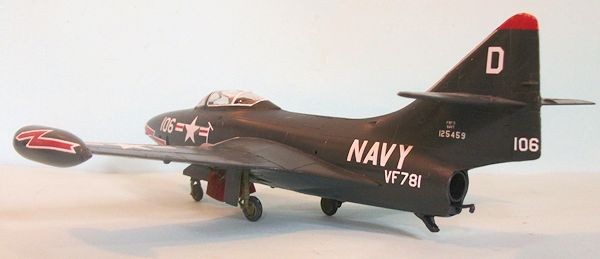 It wasn’t over.
“As I maneuvered to avoid the wreckage, I was porpoising to try
and clear my tail. I was tracking another wounded MIG when I suddenly spotted
one of the others as he slid in on my six. He fired a burst with his 37mm cannon
and hit me in the wing.
The shell went into the engine and messed up the
hydraulic unit in the accessory section and I suddenly lost rudder and flaps and
only had partial aileron control; the only thing that really worked were the
elevators.
I dove toward the cloud deck below at 13,000 feet, and he was 500
feet behind me and still shooting.
My wingman finally got back in the fight and came in on
him and he pulled away as I went into the clouds.”
Williams was in serious trouble as he fought for control
of the Panther, hoping he could pull out of his dive.
“I came out of the clouds at around 400 feet.
I was too low to eject; you had to be above 1,200 feet
and climbing to successfully eject from a Panther, so I was stuck with staying
in the airplane, like it or not.
I soon discovered it was uncontrollable below 170 knots,
so I had to maintain high speed regardless.”
Several of the destroyers escorting the task force
opened fire on Williams as he passed a few hundred feet overhead.
“Fortunately, I was low enough and fast enough they
didn’t have a chance to really aim, so nobody hit me.”
It wasn’t over.
“As I maneuvered to avoid the wreckage, I was porpoising to try
and clear my tail. I was tracking another wounded MIG when I suddenly spotted
one of the others as he slid in on my six. He fired a burst with his 37mm cannon
and hit me in the wing.
The shell went into the engine and messed up the
hydraulic unit in the accessory section and I suddenly lost rudder and flaps and
only had partial aileron control; the only thing that really worked were the
elevators.
I dove toward the cloud deck below at 13,000 feet, and he was 500
feet behind me and still shooting.
My wingman finally got back in the fight and came in on
him and he pulled away as I went into the clouds.”
Williams was in serious trouble as he fought for control
of the Panther, hoping he could pull out of his dive.
“I came out of the clouds at around 400 feet.
I was too low to eject; you had to be above 1,200 feet
and climbing to successfully eject from a Panther, so I was stuck with staying
in the airplane, like it or not.
I soon discovered it was uncontrollable below 170 knots,
so I had to maintain high speed regardless.”
Several of the destroyers escorting the task force
opened fire on Williams as he passed a few hundred feet overhead.
“Fortunately, I was low enough and fast enough they
didn’t have a chance to really aim, so nobody hit me.”
Landing speed for
a Panther is 105 knots, but there was no way Williams could do that.
Oriskany cleared her deck,
turned into the wind and cranked up to full speed, bucking through the huge
waves at 30 knots as the flight deck rose and fell through a 20 foot arc.
It was obviously going to be a crash landing.
“I didn’t want to ditch, because I wasn’t sure I could
make a successful ditching, and that water was cold enough I knew I wouldn’t
last ten minutes even in my poopy suit. The Oriskany’s captain headed the ship
just away from the wind, which gave me the opportunity to come aboard, and I
caught the three wire and shut her down.”
Williams climbed
out to examine his riddled airplane.
The Panther had taken 263 hits, mostly 23mm, and
Williams had fired off all 760 rounds of his 20mm cannons.
“That 37mm hit in the engine accessory compartment had
been really lucky. Had
it been one foot aft it would have blown up the engine; had it been one foot
forward, it would have severed the spar and blown off my wing.”
After removing everything of value from BuNo 125459, the
deck crew heaved the broken carcass overboard and it disappeared into the dark
sea.
Williams’ battle
was truly a performance for the record books.
However, so far as the Navy was concerned, this opened
the proverbial “can of worms” and would be unheard-of for fifty years.
A preliminary version of the mission was compiled that
became the official story, though it had little connection with the actual
facts: Williams was credited with a kill. Lt.(j.g.) John Middleton, wingman to
Division leader Elwood was vectored toward a descending MIG at the end of the 35
minute flight; as he approached and fired a burst out of range, the pilot
ejected, and he was credited with a single kill. Williams’ wingman, Dave
Rowlands - who never fired a shot in the entire combat - was awarded a probable.
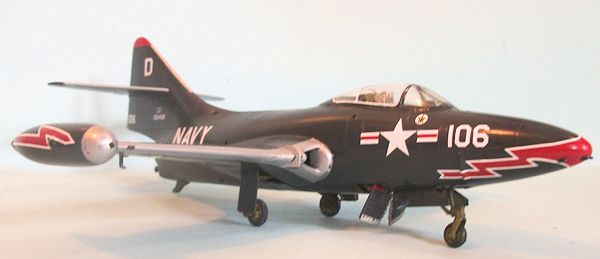 Once the Oriskany returned to Yokosuka
the following week, Williams was ordered to report to Vice Admiral Robert P.
Briscoe, Commander Naval Forces Far East, who informed him that the then-new
National Security Agency had a team aboard the cruiser USS
Helena which recorded all the Russian radio traffic leading
up to and during the fight; they had warned the fleet when the Russians decided
to send aircraft into the combat area.
There was no way the fight could be publicized, since
there was too much chance the Russians would learn how they had been spotted.
At the highest levels of US and UN command, there was
real fear that such an “incident” between US forces and Soviet forces could
change the “police action” of Korea into World War III.
Never mind that Air Force pilots were fighting hundreds
of Russian “volunteers” flying MiG-15s with North Korean markings in “MiG
Alley,” this was a fight that had directly pitted the two great Cold War
adversaries against each other nose-to-nose.
The Admiral told Williams the NSA team had proof he had
gotten at least three of the MiGs, and that the fourth had crash landed.
Unfortunately, his gun camera footage had been “edited”
by a sailor aboard the Oriskany and
only showed portions of the encounter, with two MiGs being hit solidly.
Once the Oriskany returned to Yokosuka
the following week, Williams was ordered to report to Vice Admiral Robert P.
Briscoe, Commander Naval Forces Far East, who informed him that the then-new
National Security Agency had a team aboard the cruiser USS
Helena which recorded all the Russian radio traffic leading
up to and during the fight; they had warned the fleet when the Russians decided
to send aircraft into the combat area.
There was no way the fight could be publicized, since
there was too much chance the Russians would learn how they had been spotted.
At the highest levels of US and UN command, there was
real fear that such an “incident” between US forces and Soviet forces could
change the “police action” of Korea into World War III.
Never mind that Air Force pilots were fighting hundreds
of Russian “volunteers” flying MiG-15s with North Korean markings in “MiG
Alley,” this was a fight that had directly pitted the two great Cold War
adversaries against each other nose-to-nose.
The Admiral told Williams the NSA team had proof he had
gotten at least three of the MiGs, and that the fourth had crash landed.
Unfortunately, his gun camera footage had been “edited”
by a sailor aboard the Oriskany and
only showed portions of the encounter, with two MiGs being hit solidly.
Williams would
remain quiet about the event for 50 years while he flew with Air Force Korean
aces at the Fighter Weapons School at Nellis, and commanded other Navy fighter
squadrons through the Cold War and three carrier air groups in Vietnam.
In 1992, following the end of the Cold War, the Russians
revealed Williams had indeed gotten four: Captain Belyakov, Captain Vandalov,
Lieutenant Pakhomkin and Lieutenant Tarshinov of the Red Navy Air Force.
Vandalov, Pakhomkin and Tarshinov had all been directly
shot down in the fight.
Belyakov, the flight leader, had been badly shot up by
Williams and crash-landed as soon as he was over Soviet territory, being killed
in the crash.
Royce Williams was the top-scoring carrier-based Naval Aviator of
the “forgotten war” and the top-scoring Naval Aviator in a Navy jet (Guy
Bordelon scored 5 in an F4U-5N Corsair and Marine Major John Bolt scored six
flying an F-86 with the Air Force).
His score of four MiGs in one fight is a performance
unequaled since.
| THE KIT |
 the
godawful Trumpeter F9F-2, about which the less said the better.
The kit comes from the days of raised detail, and makes
up easily into an excellent model.
The kit was re-released about 5 years ago by Revell,
asnd might be yet re-released though there are rumors that the molds were
completely changed in order to finally release the F9F-5P. At the time, a number
of decal sheets were released by SuperScale, Aeromaster and Eagle Strike, and
these are still available at eBay prices from collectors.
the
godawful Trumpeter F9F-2, about which the less said the better.
The kit comes from the days of raised detail, and makes
up easily into an excellent model.
The kit was re-released about 5 years ago by Revell,
asnd might be yet re-released though there are rumors that the molds were
completely changed in order to finally release the F9F-5P. At the time, a number
of decal sheets were released by SuperScale, Aeromaster and Eagle Strike, and
these are still available at eBay prices from collectors.
| CONSTRUCTION |
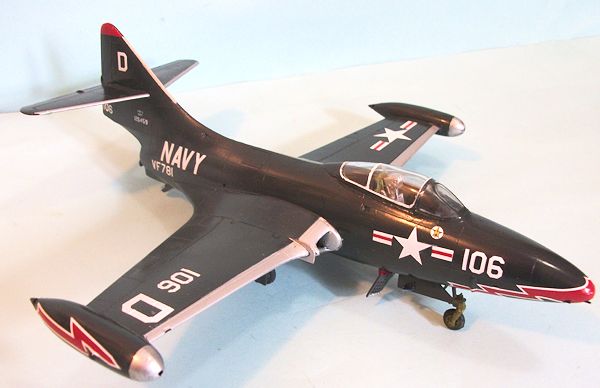 This is an easy build, in fact it is so easy it would be a good first model for
someone re-entering the hobby after a long absence, or someone deciding to build
their first plastic model.
This is an easy build, in fact it is so easy it would be a good first model for
someone re-entering the hobby after a long absence, or someone deciding to build
their first plastic model.
| COLORS & MARKINGS |

The Eagle Strike
sheet offers decals to do the aluminum leading edges of the wings and tail and
tip tanks, which I used to see how they work.
They do work, but they were such a hassle that if I do
another kit I will go back to painting those areas with aluminum paint and then
masking them before applying the Glossy Sea Blue finish.
There were no white stencils available, so I had to take
a pass on them.
I attached the
landing gear, put the ejection seat in the cockpit, and attached the canopy in
the closed position.
| CONCLUSIONS |
Review Kit courtesy of
my wallet.
If you would like your product reviewed fairly and fairly quickly, please contact the editor or see other details in the Note to Contributors.